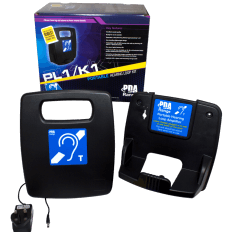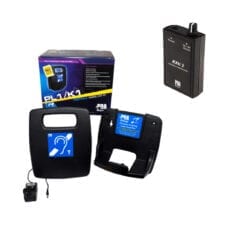BLOG
Home » Fixed Versus Portable Hearing Loops – What Should You Choose? – Hearing Loop
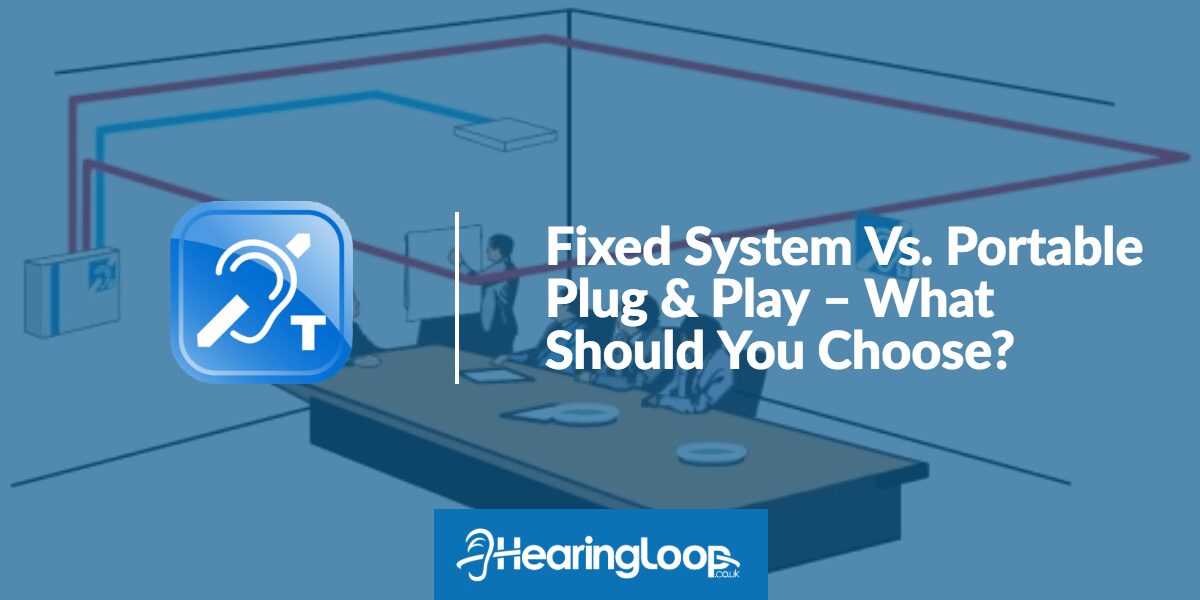
Introduction to Fixed Versus Portable Hearing Loops
Fixed Versus Portable Hearing Loops can be a dilemma when you begin to weigh up your options, it can seem like a fixed system is a more robust, powerful option.
This view often comes from the fact that many businesses and public spaces still utilise fixed systems and, with a big install being part of a fixed loop system, it can make it seem like this is the more sturdy, professional option. In reality, this isn’t the case.
A portable hearing loop system can provide all of the functions of a fixed hearing loop system and much more besides.
At the same time, the hassle-free, quick install of a portable system doesn’t mean it’s a stopgap or lightweight option, just the opposite.
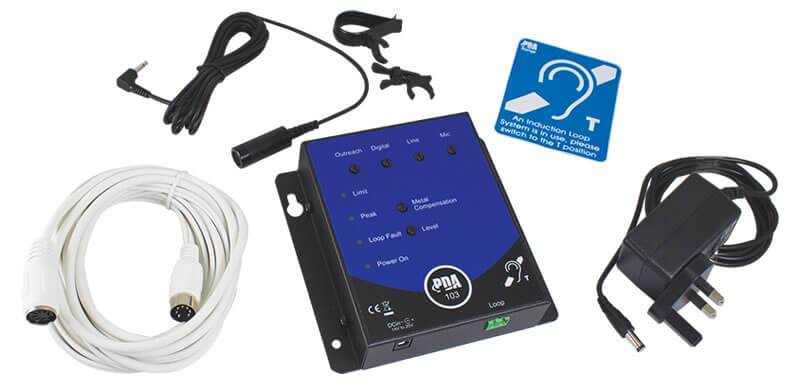
No Install Vs. Install
Bringing a hearing loop system on site doesn’t need to be a disruptive experience for your business or space, but it probably will be if you choose a fixed hearing loop system.
This is because a fixed system requires a survey, cabling and calibration, plus the installation of other equipment on site.
What this means for your business or organisation is that the rooms and areas you want to be covered by the system will definitely be out of operation during the install process.
For businesses with things to do and deadlines to meet, this can be hugely problematic and that’s before you get into hearing loops that need confining to a single room to avoid overspill into a nearby area.
In these cases, not only does the already more expensive cost of a fixed system rise even more, it means a more complex installation process is required.
For a closed loop restricted to one room, the installation requires a honeycomb cable configuration and, thus, is more labour intensive and takes longer to complete. Fixed Versus Portable Hearing Loops Further Considerations
A portable system, on the other hand, has none of these complications or disruptions.
All that’s required to get a portable hearing loop system up and running is some simple connection of devices and you’re done.
-
Offer!

PL1/K1 Portable Hearing Loop & Shelf (1.2m2)
£233.00£149.00 exl VATSaving £84.00 each exl VAT
SKU: PL1/K1
Add to cart -
Offer!

PL1/K3 Portable Hearing Loop & Carry Case (1.2m2)
£336.00£215.00 exl VATSaving £121.00 each exl VAT
SKU: PL1/K3
Add to cart -

PL1/K1 SSB Portable Hearing Loop Self Service Bundle
£199.00 exl VATSKU: PL1/K1 SSB
Add to cart
This ease of use doesn’t mean that a portable system is somehow inferior in its performance – quite the opposite.
A portable hearing loop system can deliver everything a fixed loop system can, just with more flexibility for the user and your business.
Additionally, the install costs with a portable system are negligible.
You may decide to install the system yourself and even if you do bring in a professional to ensure everything is done properly, the costs will still be far less than those associated with a fixed hearing loop system.
This is true further down the line too, with the maintenance costs of a portable hearing loop for meeting rooms for example, dwarfed by those of fixed loop systems.
Fixed Versus Portable Hearing Loops – Costs Compared
With the above in mind, let’s look a little more closely at how the costs of fixed and portable hearing loop systems stack up.
In the case of a fixed system, an average room will cost £700 -£1500 for installation – depending on the size of the space.
This price will rise, however, if your space has a room or even multiple rooms that require a confined loop.
In these cases, you will need a specific piece of equipment called a phased shifting loop amplifier which start at around £900.
Additionally, cabling is more complex in these areas and, in order to ensure no overspill into nearby rooms, install will take longer and, again, be more expensive.
The major pain point for many businesses is the fact that a fixed system cannot be removed and taken away in the event of a relocation.
This means having to go through the whole process again at the new site. If you choose a portable hearing loop system, up-front component costs can be comparable to a fixed system, however this is more than offset by a lack of installation costs and better value overall.
A simple two-pack portable hearing loop system will cost around £800.
This gives you everything you need to provide coverage for a single room.
Crucially, there is no disruptive installation process or survey needed.
You simply put the portable system in the room you choose, set it up and off you go.
If, in the future, you want to upscale your portable hearing loop system, the whole process is just as simple again.
In the case of a fixed system, this would mean another survey and more installation work and, ultimately, losing the use of vital space yet again.
In the final analysis, a portable system offers faster install, less disruption, less inconvenience and a potentially much cheaper option than a fixed hearing loop system.
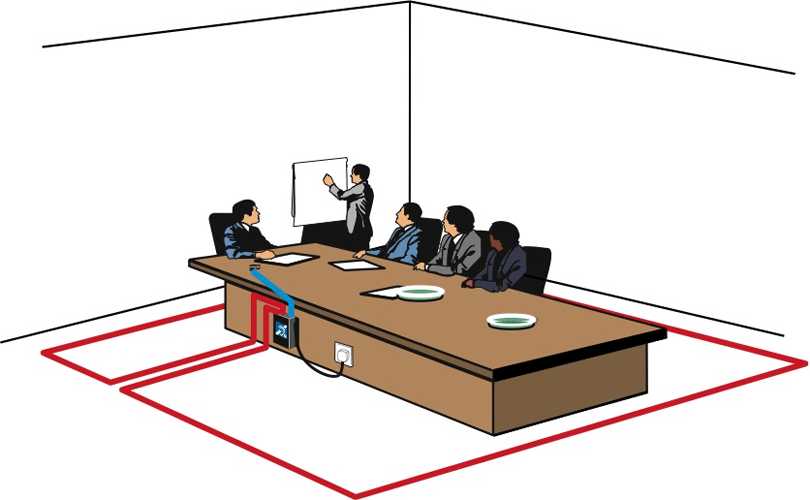
Fixed Versus Portable Hearing Loops – Access
With a portable hearing loop system, you benefit from a flexible approach to user access.
The Roger system is supplied with a dedicated headset per receiver.
This means that someone who suffers with hearing loss but doesn’t have a hearing aid can quickly and seamlessly access the system straight away.
In contrast, those without a hearing aid would need an additional piece of equipment (a loop listener) to use a fixed loop system.
In short, a portable hearing loop system is a more flexible option with and even without a hearing aid, gives users access the system that they need.
If you want to find out more about portable hearing loop systems, download our guide. Alternatively, contact us today and see how we can help you.
Call 0114 2357 717 or email us at info@hearingloop.co.uk to get connected to one of our hearing loop experts.
Categories
- Assisted Living (3)
- Communication (4)
- Compliance (2)
- Cordless Telephones (3)
- Design Survey (1)
- Features & Benefits (1)
- Features & Benefits (1)
- General Hearing (4)
- Hearing Loop Systems (14)
- Hearing Loop Uses (4)
- Hearing Loops (29)
- Installation & Commissioning (3)
- Installation & Commissioning (1)
- Portable Hearing Loop (3)
- Portable Hearing Loops (15)
- Service & Maintenance (2)
- Service & Maintenance (1)
- Uncategorized (2)
Recent Posts
- 10 Remarkable Benefits of Using the PL1/K1 Portable Hearing Loop System
- The Ultimate Guide to Phonak Roger ON: How It Works and Who It’s For
- The PL1/K1 Portable Hearing Loop: A Game-Changer for Midwives and Community Healthcare Providers
- Future Proofing Your Portable Hearing Loop System Investment
- What is Hearing Loop Technology?


